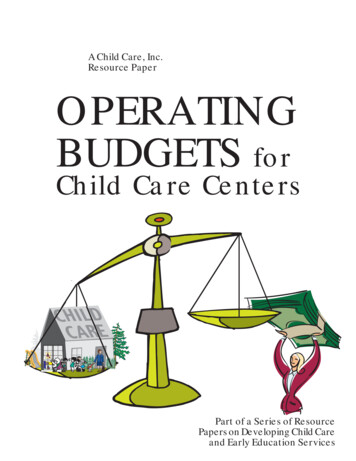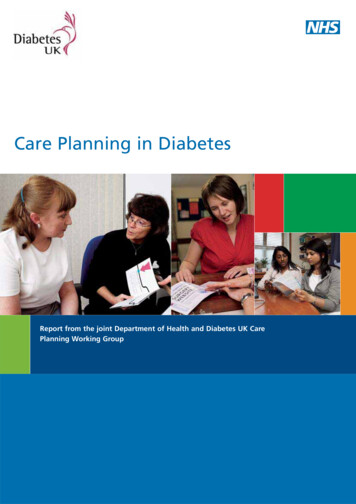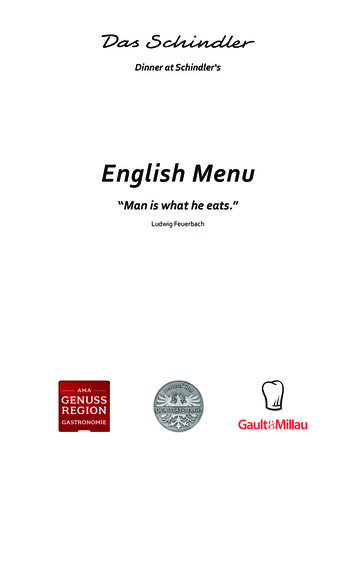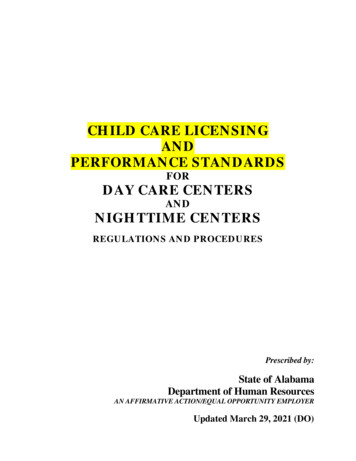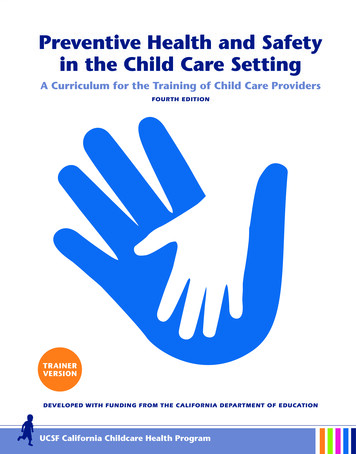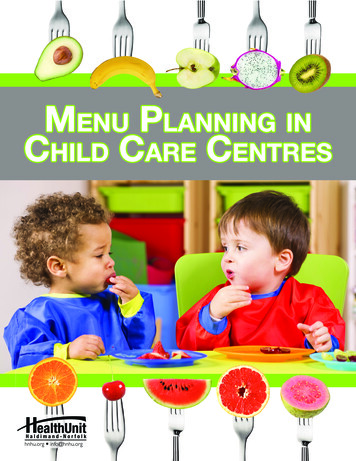
Transcription
Menu Planning inChild Care Centreshnhu.org info@hnhu.org
TableofContentsIntroduction . 5Nutrition Requirements of the Child Care and Early Years Act (CCEYA) . 6Nutrition for Healthy Term Infants (6-24 Months) . 6Eating Well with Canada’s Food Guide . 7What is a Food Guide Serving? . 8Child Size Portions . 8Additional Tips for a Nutritious Menu . 9Menu Planning Steps . 10Reducing Choking Hazards . 12Two Weekly Sample Menus . 13Information About Food Labels . 14Choosing a Healthy Cereal . 14Choosing a Healthy Cracker . 14Fibre and Grain Products . 15Sodium . 15Planning for Vegetarian Diets . 16Planning for Children with Food Allergies . 16Creating a Supportive Meal and Snack Time Environment . 17Healthy Celebrations . 18Healthy Celebrations Inspiration . 18Healthy Fundraising . 19Food Safety . 20Inspirations for Menu Planning . 22Recipes for Meals and Snacks . 24Soy Butter Yogurt Dip . 24Cinnamon Yogurt Dip . 24Sweet Potato & Chickpea Dip . 25Broccoli Salad . 26Salmon Salad Pita Pockets . 27Bean and Cheese Quesadillas . 28Crispy Oven-Baked Fish Fillets . 28Black Bean Burgers . 29Broccoli and Cheddar Mini Quiches . 30Pumpkin Raisin Muffins . 31Making Homemade Soup . 32Looking for More Recipe Ideas or Resources . 32Menu Template . 33Menu Assessment Checklist . 35Healthy Eating Environment Checklist . 38
4Menu Planning at Child Care Facilities
IntroductionHealthy eating helps children learn, play, grow and develop. The eating habits children learn carry over intoadulthood. What you do in your child care setting will influence their eating habits and how they feel about food.This booklet has been designed to assist you in planning nutritious menus for your child care facility that meet theChild Care and Early Years Act (CCEYA) from 2014 and follow Eating Well with Canada’s Food Guide released in2011.If you have any questions about this booklet or if you would like more information about healthy eating for infants,toddlers, and preschoolers, contact a Public Health Dietitian from the Maternal and Child Health Team of theHaldimand-Norfolk Health Unit. Call (519) 426-6170 or (905) 318-6623 or visit www.hnhu.org/childcare.Adapted with permission by City of Hamilton, Public Health ServicesMenu Planning at Child Care Facilities5
Nutrition Requirements of the ChildCare and Early Years Act (CCEYA)The regulations under the Nutrition Requirements of the CCEYA mandate that all infants and childrenattending child care centres in Ontario are provided with enough safe and nutritious food to meet theirindividual energy and nutrient requirements.According to the CCEYA, operators shall ensure that: Parents provide written feeding instructions for all children less than one year of age.Parents provide written instructions for all children with special dietary needs. Food or drink provided byparents must be clearly labeled with the child’s name and the date the food was sent to the centre.Food or drink is stored in a manner that maximizes its nutritive value and minimizes the risk of contamination or spoilage.A list of children with food allergies and the specifics of the allergy is posted in clear view in both thecooking and serving areas of the child care centre.Complete menus are posted in an obvious and visible location for the current and following week.Menus are kept for 30 days following the last day that it was applicable.The above points are just part of the nutrition section of the CCEYA. See the complete nutrition section ofthe CCEYA here: http://www.ontario.ca/laws/statute/14c11.Nutrition for Healthy TermInfants (For 6-24 Months)These recommendations are put out by Health Canada to help raise healthy infants and young children from 6 to24 months. The principles and recommendations are: Iron rich meat, meat alternatives, and iron fortified cereal as the first complementary foods. Progress tointroduce a variety of nutritious foods.Offer a variety of textures starting at 6 months (e.g. lumpy, mashed, pureed, minced, soft finger foods).Feed infants until 12 months on demand based on their hunger and satiety cues. After 1 year of age, feedchildren based on a regular schedule of meals and snacks.Promote finger foods to encourage self-feeding.Encourage use of an open cup.Limit fruit juice and sweetened beverages. Offer water instead.Offer foods with little or no added salt or sugar.Do not give honey (including in cooked foods) until after 1 year of age.Infants and young children must always be supervised during feeding.For more information on Nutrition for Healthy Term Infants, see www.healthcanada.gc.ca/infantnutrition.For more information on using expressed breast milk in child care centres, visit www.hnhu.org/childcare.6Menu Planning at Child Care Facilities
Eating WellGuide(forages2withCanada’s Foodyears and older)Eating Well with Canada’s Food Guide gives recommendations for the amount and types of food required each day.It has been developed to help Canadians ages two years and older meet their nutrient requirements at every stageof life.Different children need different amounts of food. In general, younger children require smaller portions than olderchildren. It’s better to start with smaller portions and provide more food if the child asks for more.For more information on Canada’s Food Guide, see www.canadasfoodguide.org.Menu Planning at Child Care Facilities7
Whatis aFood Guide Serving?Canada’s Food Guide has four food groups: vegetables and fruit, grain products, milk and alternatives, and meatand alternatives. The main meal at your child care facility should have foods from all four food groups,with two different types of vegetables or fruit (e.g. carrots and cauliflower, or broccoli and peaches). Thesnacks at your facility should have foods from at least two different food groups.A food guide serving is a reference amount. It helps you understand how much food is recommended from each ofthe four food groups. The following are examples of food guide servings according to Canada’s Food Guide.Vegetables and Fruit 125 mL (½ cup) fresh, frozen or cannedvegetable or fruit or 100% juice 250 mL (1 cup) leafy raw vegetables or salad 1 medium-sized piece of fruitGrain Products 1 slice (35 g) bread or ½ bagel (45 g) ½ pita (35 g) or ½ twelve inch tortilla (35 g) 125 mL (½ cup) cooked rice, pasta, or couscous 30 g cold cereal or 175 mL (¾ cup) hot cerealMilk and Alternatives 250 mL (1 cup) milk or fortified soy beverage 175 g (¾ cup) yogurt 50 g (1 ½ oz) cheeseMeat and Alternatives 75 g (2 ½ oz)/125 mL (½ cup) cooked fish,shellfish, poultry or lean meat 175 mL (¾ cup) cooked beans or tofu 2 eggs 30 mL (2 Tbsp) peanut butter or nut buttersSample Day MenuMorning SnackCereal with milkSliced peachesMain MealFish, brown rice,and green beansStrawberriesMilkAfternoon SnackSliced carrot sticksWhole graincrackersFor more examples of food guide servings, see www.canadasfoodguide.org.Child Size PortionsOffer food in child size portions at the main meal and snacks. An appropriate child size portion is ½a Canada’s Food Guide serving. For example, one slice of bread is considered one Canada’s Food Guide serving,so a child size portion is half a slice of bread. Offer small portions to start. Always have extra servings available ifchildren ask for more if they are still hungry.8Menu Planning at Child Care Facilities
Additional TipsMenufor aNutritiousMenu Assessment ChecklistChild Care Setting:Date:Add a checkmark in the box for each requirement that is met.1. Whole grain choices are served at least half the time (barley, brown rice, oats, quinoa,couscous, pasta, tortilla, pitas, crackers, breads and oatmeal).2. Dark green vegetables (broccoli, romaine lettuce, asparagus, spinach) and orange vegetables orfruits (carrots, sweet potatoes, winter squash, pumpkin, apricots, cantaloupe, canned peaches,nectarines and mangoes) are served most of the time.3. Meat alternatives such as beans, eggs, soybeans, lentils and tofu (egg sandwich, baked beans,hummus/bean dips, pea soup, vegetarian chili) are served at least once a week.4. Fish is served at least once a week (salmon loaf, tuna casserole, tuna croquettes, fish burgers,fish fillets). For assistance in choosing types of fish, visit: www.hnhu.org/childcare.YES NO5. Foods high in calories, fat, sugar and salt such as cakes, pastries, cookies, ice cream, deep friedfoods and hot dogs are limited or not served at all.6. The menu includes foods with different: Colours Shapes (shredded, in strips, cubes, slices of different sizes) Temperatures and textures (cooked, raw, crispy, crunchy, chewy, smooth consistencies).7. The menu includes: Foods that are easy to eat and suited to the children’s personal and cultural preferences. Some finger foods.8. The menu includes food choices that are safe to eat: Foods that can cause choking such as peanuts, nuts, seeds, whole grapes, raw vegetables andchunky peanut butter are excluded from the menu for children under the age of 3. Popcorn and hard candies are excluded from the menu for all children.9. The menu excludes sticky, sweet foods such as dried fruit and candy, which can stick to theteeth and cause cavities (unless children brush their teeth right after or dried fruit is servedwith a piece of hard cheese).10. The menu limits juice to one serving per day, or none at all (125 mL or 4 oz). Juice is 100%unsweetened fruit juice.Menu Planning at Child Care Facilities9
Menu Planning StepsTo plan your menus, there are 10 steps which can help your centre meet the CCEYA and Canada’s Food Guide.Below each step, there are ideas on how to serve different foods and menu suggestions.For each day of the week:1. Select the meat or meat alternative for eachmain meal.2. Select a vegetable for each main meal.3. Select one more vegetable or fruit foreach main meal.4. Select grain products for each main meal.5. Select milk or a milk alternative for eachmain meal.6. Plan morning and afternoon snacks tocomplement meals.7. Use healthy oils and fats.8. If you offer dessert, it can be chosen fromone of the four food groups.9. Plan beverages for main meal and snack.10. Additional things to consider for menu foryour menu.1. Select the meat or meat alternative for each main meal for each day of the week.Cook’s Tip: For breading fish, use a small amount of mayonnaise or milk and then coat withbreading such as bread crumbs or crushed dry cereal. Serve with lemon slices. Choose a different food from the Meat and Alternatives group (e.g., fish, poultry, beef, pork, eggs, tofu andlegumes such as black beans, split peas, or lentils) for each day.Serve fish at least 1 time per week.Include meat alternatives such as legumes (kidney beans, chick peas, lentils) and tofu at least once a week.Choose lean meat and alternatives prepared with little or no added fat or salt (e.g., remove chicken skin,avoiding deep-fried food).Add or purée legumes into sauces (e.g., pasta, pizza), chili, dips and soups.Cook’s Tips: For macaroni and cheese, blend lentils and add to cheese sauce. Another idea: mixpuréed cooked red lentils or beans into pasta sauce – use leftovers as pizza sauce.2. Select a vegetable for each main meal for each day of the week. Provide dark green vegetables (e.g. asparagus, green beans, bok choy, broccoli, brussel sprouts, lettuce, greenpepper) and orange vegetables (e.g. carrots, squash, pumpkin, sweet potato) often. Choose vegetables prepared with little or no added fat, sugar, and salt. Include a variety of cooked and rawvegetables throughout the week. Use different textures and shapes, such as grated, chopped, mashed, sliced, cubed, sticks, wedges. Serve avariety of vegetables in many different colours. Consider growing some of your own vegetables on site. Involve children in selecting, planting and caring fora variety of vegetables and fruits. Carrots, beans, tomatoes, cucumbers, squash and pumpkins grow well andchildren enjoy them. Use them in baked products. Try adding carrots, zucchini, pineapple or bananas to breads or muffins. Serve low-sodium vegetable soups. Add puréed or grated vegetables to soups, sauces and casseroles.Cook’s Tip: Offer one hot/cooked and one cold/raw vegetable at lunch.10Menu Planning at Child Care Facilities
3. Select one more vegetable or fruit for each main meal for each day of the week. Serve vegetables or fruit prepared with little or no added fat, sugar and salt. Frozen and canned vegetables or fruit (in water or its own juice) are healthy options. Choose fruit more often than fruit juice. Cut in shapes (e.g., for a kiwifruit, cut in slices, or cut in half and let kids scoop it out). Serve vegetables and fruits that are in season and locally grown. Freeze batches of seasonal produce if thisis an option for your facility.4. Select grain products for each main meal for each day of the week. Offer at least half of the grain products as whole grain each day. Examples include whole grain breads,whole grain pastas, and brown rice. Include a variety of other grain products such as oats, barley, couscous, quinoa, bagels, english muffins, pitas,tortillas, roti, chapatti, and bannock. Choose grain products that are lower in fat, sugar and salt.Cook’s Tip: Use whole grain bread to make French toast to get a serving of grains and meat and alternatives.5. Select milk or a milk alternative for each main meal for each day of the week. Offer 1% or 2% milk each day for children age Offer milk at lunch.2 years and older. Serve whole milk (3.25% milk Milk, yogurt or cheese can be served at snackfat) for children less than 2 years of age.times. Cow’s milk is the milk of choice, unless other Serve milk-based soups and smoothies.wise specified by the parent. Add grated cheese to foods when appropriate.Cook’s Tip: Use yogurt in dips for vegetables and fruit.6. Plan morning and afternoon snacks to complement main meal. Offer food from at least two food groups of Canada’s Food Guide at each snack. Include foods from the vegetables and fruit food group in at least one snack each day. Choose snacks that are both nutritious and promote good dental health (i.e., limit sweet and sticky foods). Serve snacks around 2 hours before the next meal so children are hungry for the meal. See list of Snack Ideas in this booklet (p. 22-25).7. Healthy fat is good for children’s growing bodies. Use some healthy fats throughout the menu.Some examples of healthy fats include: Vegetable oils (e.g., canola, olive and soybean) Mayonnaise Soft margarines made from non-hydrogenated oil Salad dressings(look for margarines with no trans fat) Avocado8. If you offer dessert, it can be chosen from one of the four food groups. Some nutritious dessert ideas are fresh, frozen or canned fruit, yogurt, homemade milk puddings,homemade applesauce and homemade fruit crisp. It is not necessary to plan desserts such as cake or ice cream.Menu Planning at Child Care Facilities11
9. Plan beverages for each main meal and snack. Provide milk at each main meal. Provide water at each snack. Also have water available throughout the rest of the day. If juice is served, limit to 125 mL (1/2 cup or 4 oz) per day. Choose 100% fruit juice. Do not serve fruitpunches, drinks, cocktails, beverages, sports drinks, pop/soft drinks, and energy drinks.You may have to remind children to drink water, especially when it is hot outside and when they are doinga lot of physical activity.10. Additional things to consider for menu: Use at least a three or four week menu cycle. Introduce at least one new food during the menu cycle. Include new foods one at a time in small quantities.Serve them with foods that are well-liked. Avoid having the same menu item always falling on the same day of the week (i.e., pasta every Monday). Celebrate different cultures by introducing food choices that represent the ethnic diversity of your childcare centre. Involve parents in helping you plan some new menu choices. Provide child-sized utensils, bowls, and plates. Do not serve honey (or use in cooking) for children under one.Foods to limit or avoid: Hard margarine (contains trans fats),shortening, lard and butter Accompaniments, dips, and sauces suchas ketchup, mustard, relish, creamy saladdressing, gravies, jams, jellies, creamcheese, sour cream and syrup High fat baked products like pastries,danishes, cakes, pies, donuts, tarts, cookies Ice cream, sherbert, popsicles Sugary cereals ChocolateMarshmallowsChips, cheese puffs, friesCured and processed meats such ashotdogs, sausages, pepperoni, bacon, andsalamiBeverages other than water, milk orjuice such as fruit punch, milkshakes, hotchocolate, etcReducing Choking HazardsSince any food can cause choking, always watch children while they are eating. Have children sit down to eat andprovide a calm eating environment.How to reduce the risk of choking: 12Do not offer popcorn or hard round candies.Cut grapes in half or quarters.Grate hard vegetables such as carrots or cut them into narrow strips.Spread peanut butter, nut butter or soy butter thinly. Never serve it right off a spoon.If served, cut hot dogs and sausages into long strips, and then into bite-size pieces.Menu Planning at Child Care Facilities
Two Weekly Sample MenusMondayAM Yogurt Orangessnack Homemadechickennoodle soup Whole wheatbreadunch Cooked carrotsand peas Canned pears injuice Milk Baked pitacrisps withmelted cheesenack& salsaLPMSMondayAMsnackPMSnack Whole graincereal Milk Mushroom andham quiche Broccoli Sliced apples MilkWednesday Hard boiledegg Whole wheattoast Homemadechili withvegetables Brown rice Choppedcauliflower Tangerinepieces MilkThursdayFriday Homemadechickenfingers Whole wheatbun Salad Kiwi Milk Tuna saladsandwiches onwhole wheatbread Slicedcucumbers Banana Milk Slicedcantaloupe Bread sticks Carrot branmuffins Yogurt Yogurt pops Whole Wheat Cereal Raw veggies andwraps with Thaweddipcucumber,frozen fruitgreen peppers, Milk& hummus Cheese andcrackers SlicedpeachesTuesdayWednesdayThursdayFriday Turkey on awhole wheatbun Cucumberslices Sliced grapes Milk Beef stir-frywith broccolion brown rice Pineapple Milk Homemadetomato soup Salmonsalad pitapockets** Cannedpeaches injuice Milk Homemadebanana bread Sliced strawberries Pasta with lentiltomato sauce Spinach salad Orange slices Milk Whole wheat SlicedMelba toastcantaloupe Cheddar cheese Cinnamonyogurt dip** Whole wheatchicken fajitaswith redpepper strips unch Slicedwatermelon MilkLTuesday Shredded wheat Whole grainsquare cerealcrackerswith milk Cheese cubes Bananas Pumpkin raisin Whole wheat Oatmealmuffins**English Thawed frozen Orange juicemuffins withblueberriescheese Fruit salad Milk Pita triangles HummusFor more menu ideas, go to www.hnhu.ca/childcare. **Recipes can be found in this booklet (p. 26-34)Menu Planning at Child Care Facilities13
Information About Food LabelsIngredient List - The ingredient list tells you what ingredients are in the packaged food. They are listed by weightfrom the most to the least. This list is a source of information for people with food allergies or health concerns.Check out the following food labeling websites for more information:EatRight Ontario: www.eatrightontario.ca and search “Nutrition labelling” for 5 short videos and fact sheets onnutrition labelling.ChoosingaHealthy CerealCereal with milk can be a healthy balanced snack that contains a variety of vitamins and minerals and can be goodsource of fibre.When choosing a cereal, look for one that has: A whole grain as the first item on the ingredient list 2 g of saturated fat per serving 2 g of fibre per servingTo choose an even healthier cereal, look for one that has 4 g of fibre and 240 mg of sodium per serving andlower amounts of sugar.Cereals to try: Cooked rolled oats, multi grain squares, oat ring cereal, bran flakes, shredded wheat squares,frosted wheat squaresChoosingaHealthy CrackerWhen choosing crackers, look for those that have: 3 g of fat per serving 2 g of saturated fat per serving 240 mg sodium per servingTo choose an even healthier cracker, look for ones that have whole grain listed as the first ingredient and 2 g offibre per serving.*Criteria was taken from Nutrition Tools for Schools (www.nutritiontoolsforschools.ca), developed by the Ontario Society of Nutrition Professionals in Public Health(OSNPPH), accessed Sept. 13, 2012.14Menu Planning at Child Care Facilities
FibreandGrain ProductsFibre is a very important component of food. Fibre provides us with a feeling of fullness, promotes regular bowelmovements, and can relieve constipation.How to include more whole grains in your menu: For morning snack, offer whole grain toast or breakfast cereal. Use 100% whole grain bread for healthy and delicious sandwiches. Try whole grain pasta when planning dishes with spaghetti, macaroni or lasagna noodles. When making muffins or pancakes from scratch, substitute whole wheat flour for half of the white flour. Offer brown rice instead of white rice. Try recipes that use whole grain barley, kasha, bulgur, quinoa, millet and couscous.Descriptive words in the product’s name, such as stone-ground, multi-grain, 100% wheat, or bran, do not necessarily indicate that a product is whole grain. Words to look for include “100% whole grain,” “whole rye,” “whole oat oroatmeal,” “100% whole wheat” or “whole grain whole wheat.”For more information on whole grains, including recipes, see EatRight Ontario’s handout “Choosing Whole Grains”at Sodium (Salt)Most Canadian children and adults consume too much sodium, the major component of salt, in foods they eat.Foods high in sodium include processed and convenience foods, processed meat, soups, and some snack foods.How to reduce sodium in your menu: Use less processed and packaged foods. Make your own soups with water and/or lowsodium broth. Avoid adding salt to cooking water. Season foods with fresh or dried herbs, garlic,ginger, lemon, lime, no-sodium seasoning mixes,and/or pepper. Buy unsalted or lower sodium foods whenpossible (e.g., lower sodium vegetable juice,broth, crackers). Avoid or limit high sodium foods and condimentssuch as pickles, olives, ketchup and soy sauce. Use quick cooking oats instead of instant hotcereals.Buy fresh or frozen vegetables. Rinse regularcanned vegetables or look for ones with low orno sodium added.Choose lower sodium canned beans or driedbeans, peas and lentils. Rinse canned beans.Choose unseasoned fresh or frozen fish, meatand poultry. Avoid high salt meets such as delimeats, hot dogs, sausages and pre-seasoned fish,meat and poultry.Menu Planning at Child Care Facilities15
PlanningforVegetarian DietsThere are many different types of vegetarian diets. Check out www.eatrightontario.ca and use the key word“vegetarian” to search for more information. Canada’s Food Guide (CFG) is suitable for vegetarians. Useparents as a resource when planning meals. Ask them what types of food they serve at home. When planning avegetarian meal, the meat must be replaced with a meat alternative such as legumes (e.g., canned beans, lentils),eggs (if permitted), soy products (e.g., tofu, vegetarian meat substitutes), seed/nut butters (if permitted), or fish (ifpermitted).Vegetarian IdeasThe following examples are not whole meals, but ideas for replacing the meat portion of a menu item with a meatalternative. Always remember to include all four food groups with meals. Vegetable omelettesVegetarian quiche or crustless quicheBaked beans on toastLentil soup and breadLentils and riceNut butter sandwiches (e.g., peanut butter,almond butter, soy butter, cashew butter, etc.)Vegetarian chili or pasta sauce using texturedvegetable protein (e.g. veggie ground round),tofu and/or beans Quesadillas made with blackbeans (see page 28)Bean or lentil saladBean tacosTofu and vegetablestir-fry with ricePlanning for ChildrenAllergieswithThere are several steps you can take at your facility to prevent allergic
To plan your menus, there are 10 steps which can help your centre meet the CCEYA and Canada’s Food Guide. Below each step, there are ideas on how to serve different foods and menu suggestions. For each day of the week: 1. Select the meat or meat alternative for each main meal. 2. S

